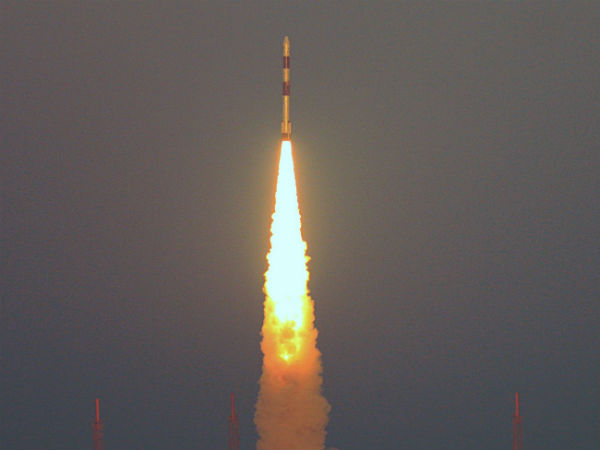
Upanishads to Upagraha: India's giant leap

This is India's fourth fully commercial launch, but 27th launch of PSLV. It is carrying five satellites from four countries namely France, Germany, Canada and Singapore. The PSLV-C23 which is standing around 44.4 metres tall and weighing around 230 ton will take away SPOT-7, NLS-7.1 (CanX-4), NLS-7.2 (CanX-5) and AISat satellites. The launch vehicle costs Rs. 100 crores.
Congratulating scientists for the launch of PSLV C23 rocket, Prime Minister Modi said that every Indian should feel proud of the moment. "We are proud that our program is indigenous. Generations of scientists have worked to make India a self-reliant space power," he said.
Further, highlighting India's rich heritage, the Prime Minister said India has come a long way from Upanishads to Upagraha. "India has a rich heritage of science & technology & our relationship with science is deeply rooted with knowledge."
What PSLV-C23 is carrying away:
The rocket's main luggage is the 714 kg French earth observation satellite SPOT-7. Piggybacking on the main luggage are the four small satellites viz: 14-kg AISAT of Germany; NLS7.1 (CAN-X4) and NLS7.2 (CAN-X5) from Canada each weighing 15 kg; and the 7-kg VELOX-1 of Singapore.
The five satellites are from four countries - France, Germany, Canada and Singapore.
French satellite SPOT 7, identical to SPOT-6, which ISRO had launched in 2012, would be placed diametrically opposite to SPOT-6, forming part of the existing Earth observation satellite. European space technology company Airbus Defence and Space has built SPOT-7.
Germany's AISAT satellite would focus on the global sea-traffic monitoring system with special emphasis on high traffic zones using AIS signals. It is also Germany's first DLR satellite in the nano-satellite class.
NLS 7.1 and NLS 7.2 are from the University of Toronto, Institute of Aerospace Studies/ Space Flight Laboratory in Canada. Both payloads would perform Two-spacecraft precision formation flying using differential GPS with centimetre-level relative position and sub-metre level accurate position control system.
ISRO has so far launched 35 satellites from 19 countries.
Satellite VELOX-1 from Nanyang Technological University, Singapore is a technology demonstrator for in-house design of image sensor, MEMS-based attitude determination and control system and inter-satellite RF link.
What makes this development a landmark?
India
began
its
space
journey
in
1975
with
the
launch
of
Aryabhatta
using
a
Russian
rocket
and
till
date,
it
has
completed
over
100
space
missions
including
missions
to
moon
and
mars.
Starting
from
1999,
India
has
launched
35
foreign
satellites
till
date
using
the
PSLV
rocket,
the
first
operational
launch
vehicle
of
ISRO.
The
successful
launch
of
five
satellites
on
Monday
have
now
taken
the
tally
to
40.
As
rightly
said
by
Prime
Minister,
this
successful
launch
puts
India
in
an
elite
group
of
5
to
6
countries
who
are
self
sufficient
in
developing
space
technology.
This,
in
a
way,
is
a
global
endorsement
of
India's
space
capability
and
will
further
add
to
India's
image
at
world
forum.
All
Satellite
launched
today
were
from
developed
nations
and
it
proves
that
India
has
the
potential
to
become
the
leader
in
providing
launch
services
to
the
world.
How it will be a boost to India?
Undoubtedly, it is a step ahead towards making India a self-reliant space power. After successful launch of Chandrayaan, first unmanned lunar probe (exploration of Moon) in October 2008 and Mangalyaan (Mars Orbiter Mission) on November 5, 2013, this development will not only add to image of India but will be beneficiary in number of ways. Becoming self sufficient in space technology will be revenue generator. If India through its indigenously prepared vehicle, start offering launch services to the countries it would add to the revenue. ISRO has so far launched 35 satellites from 19 countries bringing a huge sum to the country as foreign exchange.
We
have
achieved
a
lot
&
we
have
to
go
a
long
way.
Continued
progress
in
space
must
remain
our
national
mission!http://t.co/OwVtfLUSnb
—
Narendra
Modi
(@narendramodi)
June
30,
2014
In his speech, Modi highlighted the need of technology, he said, "Technology is central to development. It touches one and all, and is an important instrument of our national progress." Modi said the country should develop more advanced satellites. As it is only satellites which help people like farmers, fisherman, and other agricultural professionals-on the ground a lot- by giving weather predictions. Their weather predictions have also helped in times of natural disaster, as they are used to evacuate civilians from dangerous areas preemptively. Recently, the timely update from the satellites saved countless lives when cyclone Phailin hit the Odisha coast. The loss of life due to Uttarakhand tragedy in July 2013, the 2004 Tsunami could have been avoided if we had up-to-date satellite technology.
Extremely
glad
to
have
witnessed
the
successful
launch
of
PSLV-C23.
I
congratulate
our
scientists
who
have
worked
tirelessly
for
the
launch.
—
Narendra
Modi
(@narendramodi)
June
30,
2014
Modi today said, "India's space programme is a perfect example of my vision of Scale, Speed and Skill." With this we could expect much more revolutionary steps ahead. As clearly said by Prime Minister 'yeh dil maange more' we should not stop here and keep working towards achieving goals to make India a self sufficient nation in every aspects.


 Click it and Unblock the Notifications
Click it and Unblock the Notifications


































